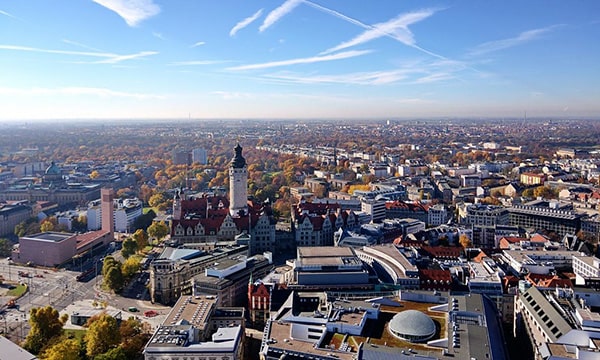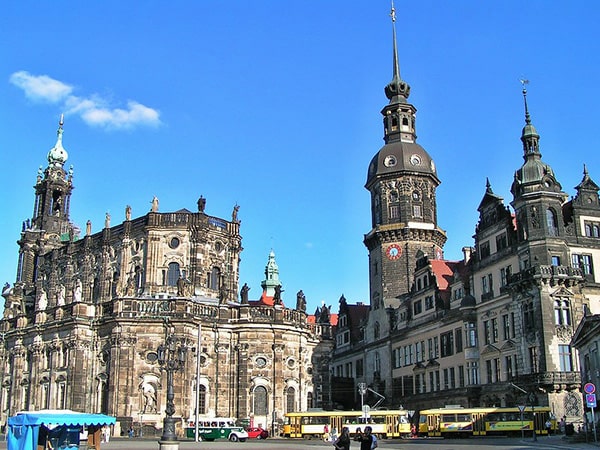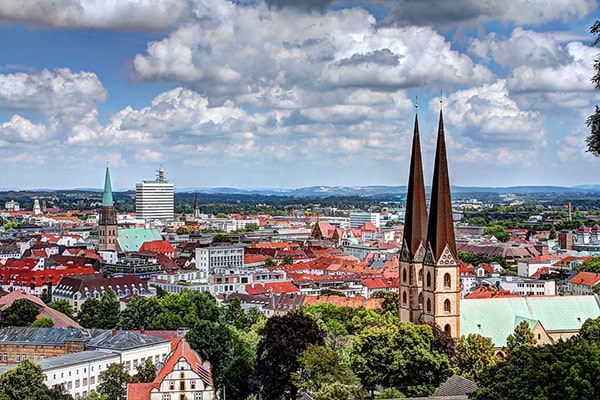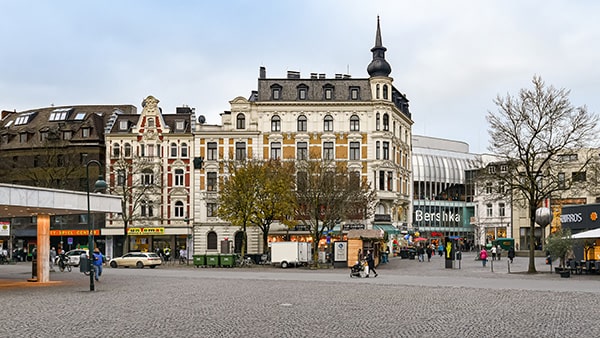Are you considering studying in Germany but worried about the costs? We’ve researched and compiled a comprehensive guide to the 7 cheapest cities in Germany for international students. Discover not only affordable living but leisure options outside school settings as well as the academic opportunities in each city.
Table of Contents
Leipzig

Leipzig is undeniably the most student-friendly city in Germany, and for good reasons. It goes from the affordable living and accommodation costs to the high student population.
This medium-sized city in the Eastern part of Germany stands out for its rich cultural heritage, including its connection with the composer, Johann Sebastian Bach. Moreover, the Leipzig Book Fair and numerous publishing companies have earned the town the nickname of “Book City”.
Leipzig downtown, Plagwitz, and Südvorstadt districts, Karl-Liebknecht-Strasse and Connewitz are its main cultural centers, where many students also reside. Lastly, despite being a fairly bustling town, Leipzig offers ample green spaces such as the Botanical Garden, Clara-Zetkin-Park, or the Leipzig Riverside Forest.
Facts and Figures
- Average cost of living per month in Leipzig: €750-€1,400
- Accommodation cost per month: €450 – €910
- Monthly transportation pass: €49
- Number of universities: 10 including the University of Leipzig, HTWK Leipzig University of Applied Sciences, University of Music and Theatre “Felix Mendelssohn Bartholdy” and HHL Leipzig Graduate School of Management
- Student population: around 40,000 students each year, with 11% international students
Check also our ranking of the top universities in Germany for international students
Dresden

The second in our list of the cheapest cities in Germany for international students is the capital of Saxony, Dresden. Nicknamed the Florence on the Elbe, the river by which the city is located, Dresden boasts a beautiful baroque architecture.
Its most popular landmarks include reconstructed Frauenkirche and the Semperoper opera house. Other cultural attractions include the Zwinger, Theaterplatz, as well as the Old Masters Picture Gallery museum.
And for those looking for more green outdoor spots, their options are the Brühlsche Terrasse, the Large Garden, or hiking in Saxon Switzerland. Moreover, the Elbe River provides breathtaking views. Lastly, the most concentration of students is found in the district of Neustadt.
Facts and Figures
- Average cost of living per month: around €1,350
- Accommodation cost per month: between €528 and €940 outside the city center and between €800 and €1350 in the city center
- Monthly transportation pass: €67
- Number of universities: 7 including TU Dresden, Dresden International University or HTW Dresden – University of Applied Sciences
- Student population: around 40,000
Halle (Saale)

Back in Eastern Germany, Halle is a beautiful small town at just 20 minutes train ride from Leipzig. It’s another perfect spot for international students looking for affordable options for living and studying.
Halle also stands out for its numerous scenic sites, green areas, historical buildings and narrow streets. Its town center features preserved architecture from different eras. Among its most famous landmark, there are the Unserer Lieben Frauen and the Roter Turm.
In contrast with the historical and cultural landscape, Halle also hosts technical universities such as Weinberg Campus, which is an important start-up and technology center. And to accommodate the student life, the city offers a bike-friendly environment. Outside the classroom, Peissnitz Island is the favorite meeting point of students in Halle.
Facts and Figures
- Average cost of living per month in Halle: around €1,500
- Accommodation cost per month: from €225 to €350 for a dormitory room
- Monthly transportation pass: €49
- Number of universities: 3 including the Martin Luther University Halle-Wittenberg
- Student population: around 22,000
Bielefeld

The fourth city in our list is one that has been around since the Middle Ages, as it started to exist in the ninth century. Bielefeld is a lesser-known town in North Rhine-northeast Westphalia, Germany, yet it might be the cheapest of the cities of this ranking. Additionally, it has built its reputation around the manufacturing of linen.
Its main landmarks include the historic center as well as the Sparrenburg fortress. Other leisure and outdoor activity options in Bielefeld include green spaces such as Bürgerpark and Nordpark.
For students, the city offers a well-balanced big city-countryside feel. Rental prices are affordable, and the transportation system is efficient with easy bike access and free tram fares.
Facts and Figures
- Average cost of living per month: €990 without rent
- Accommodation cost per month: between €450 and €1,200 per month
- Monthly transportation pass: €49
- Number of universities: 4 including the University of Bielefeld and Bielefeld University of Applied Sciences
- Student population: around 40,000
Erfurt

The 5th city in our list is home to almost €60,000 students. Erfurt is a small city in Thuringia, in Eastern Germany – the green heart of the country. It’s a city that stands out for its medieval charm paired with an economic center comprised of media, mechanical engineering and horticulture industries.
Erfurt’s main landmarks include the Erfurt cathedral as well as the Petersberg fortress. Moreover, the city features 142 bridges, including the famous Krämerbrücke. Not far from the city, there is the Wartburg UNESCO World Heritage Site, or the Thuringian Forest, perfect for hiking.
Facts and Figures
- Average cost of living per month: around €1,300
- Accommodation cost per month: between €470 and €950 outside the city center and between €800 and €1,400 in the city center.
- Monthly transportation pass: €49
- Number of universities: 3 including the University of Erfurt and Adam-Ries University of Applied Sciences
- Student population: around 56,000
Kaiserslautern

The next in our list is one of the most international cities but also one of the cheapest in Germany for students. Also, Kaiserslautern is a small yet contemporary town located in West Germany, in the Rhineland-Palatinate state, close to the French and Luxembourgian borders. The city also stands out for its technology and innovation scene, mostly in science and IT.
The city’s main landmarks include the city hall, which offers panoramic views from the 21st floor. There are also several spots for outdoor activities, such as the Stadtpark or the Palatinate Forest. Moreover, to add to the student’s appeal, the city’s favorite means of transport are bikes and a bus network.
Facts and Figures
- Average cost of living per month: around €860-€900
- Accommodation cost per month: between €210 and €1450 depending on the number of rooms and the housing location (inside/outside the city)
- Monthly transportation pass: €49
- Number of universities: 2 including Kaiserslautern University of Applied Sciences and RPTU University of Kaiserslautern-Landau
- Student population: around 20,000
Aachen

The latest city in our list is located in the Westernmost part of Germany, near the Belgian and Dutch borders. Aachen is also a very student-centric city with not only thanks to its prestigious university and proximity to neighboring cities but also to its cultural and historical footprint.
Along with historical landmarks such as Charlemagne’s city hall and cathedral, Aachen also provides several places for outdoor and sport activities. As a matter of fact, it’s one of the most sporty cities in our list, renown for events such as the 5,555 meter Lousberg marathon or the Tivoli stadium events.
Facts and Figures
- Average cost of living per month: around €960 without rent
- Accommodation cost per month: between €500 and €1400 depending on the size and the location of the accommodation
- Monthly transportation pass: €49.75
- Number of universities: 5 including RWTH Aachen University and Aachen University of Applied Sciences
- Student population: around 58,000
Read our other comprehensive guides on studying in Germany:
10 reasons why you should study in Germany
The cost of studying in Germany and the cost of living in Germany for students
10 tips for international students in Germany
This post is also available in fr_FR.




 Aljawaz Your guide to study abroad
Aljawaz Your guide to study abroad






















